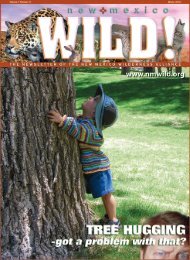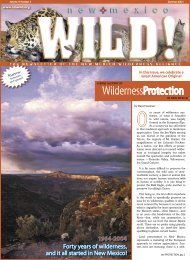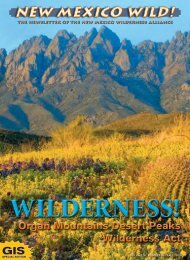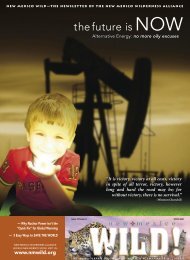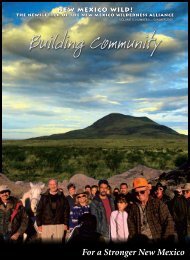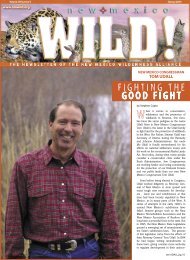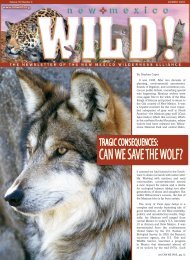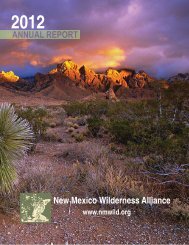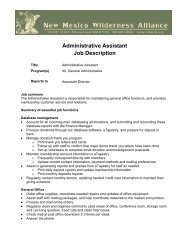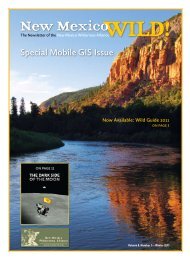Summer 2010 Newsletter - New Mexico Wilderness Alliance
Summer 2010 Newsletter - New Mexico Wilderness Alliance
Summer 2010 Newsletter - New Mexico Wilderness Alliance
Create successful ePaper yourself
Turn your PDF publications into a flip-book with our unique Google optimized e-Paper software.
Page 18 SUMMER-FALL <strong>2010</strong><br />
<strong>New</strong> <strong>Mexico</strong> WILD! • www.NMWild.org Page 19<br />
Finding the Heartbeat<br />
continued from page 17<br />
counties without any protected lands.<br />
Ultimately, though, the overarching<br />
benefit of a national monument<br />
in Otero Mesa would be that <strong>New</strong><br />
Mexicans helped protect the land for<br />
the land’s sake, and that would be<br />
something we could all be proud of.<br />
How Is a National Monument<br />
Different from Other<br />
Forms of Protection?<br />
An Otero Mesa National Monument<br />
would be managed by the Bureau<br />
of Land Management, and BLM<br />
monuments are not like national<br />
parks. There would be no use fees and<br />
generally, no major development on<br />
the designated lands. Like most other<br />
units of the BLM’s National Landscape<br />
Conservation System,<br />
monuments don’t have facilities<br />
built in them; rather, they are<br />
designed to remain rugged and<br />
offer a primitive experience.<br />
Visitor centers are often built<br />
in the communities closest to<br />
the monument, and visitors<br />
are directed to these nearby<br />
“gateway communities.”<br />
Whereas <strong>Wilderness</strong><br />
designation would prohibit any<br />
form of mechanized travel,<br />
monuments allow motorized<br />
vehicles, though access<br />
is generally restricted to<br />
designated roads. Traditional<br />
uses, such as hiking, hunting,<br />
camping, backpacking,<br />
grazing, etc. are still allowed.<br />
What’s more, monument<br />
proclamations can address<br />
specific issues in a variety<br />
of ways. Each proclamation<br />
creating a national monument<br />
is different, addressing specific issues<br />
relating to the individual place.<br />
The Oil and Gas Resources<br />
of Otero Mesa<br />
Even though oil and gas leasing<br />
and drilling has been suspended in<br />
Otero Mesa, it is important for us<br />
to understand that this resource in<br />
the region is fairly insignificant.<br />
The BLM has concluded that Otero<br />
Mesa and the surrounding area do not<br />
have the potential to yield significant<br />
oil and gas. The industry’s purported<br />
interest in developing the area is<br />
belied by these facts. The potential<br />
yield from development of Otero Mesa<br />
is minuscule in comparison to the<br />
substantial amounts of oil and gas<br />
produced in the nearby Permian Basin.<br />
At one point, <strong>New</strong> <strong>Mexico</strong> BLM<br />
Director Linda Rundell stated, “I<br />
think there’s a huge question mark<br />
about whether there’s ever going to<br />
be an economically viable resource<br />
that anyone will want to produce....<br />
It’s really pretty small potatoes.”<br />
When you analyze <strong>New</strong> <strong>Mexico</strong>’s gas<br />
consumption in 2007 versus total<br />
state gas production, and compare<br />
that with what the BLM thinks could<br />
be produced from Otero Mesa, the<br />
findings are really quite shocking.<br />
The BLM’s figure comes from the<br />
Reasonable Foreseeable Development<br />
(RFD) scenario, published in their<br />
Record of Decision, and the state gas<br />
figures can be found in reports issued<br />
by the <strong>New</strong> <strong>Mexico</strong> Energy, Minerals,<br />
and Natural Resources Department.<br />
The BLM’s RFD estimates that if<br />
all wells were drilled and all hit<br />
commercially viable amounts of gas,<br />
Otero Mesa would produce fifty-four<br />
billion cubic feet of natural gas<br />
over the course of twenty years.<br />
In 2007 alone, however, <strong>New</strong> <strong>Mexico</strong><br />
consumed 223 billion cubic feet<br />
of natural gas. Over the course of<br />
twenty years, assuming consumption<br />
levels remained static, <strong>New</strong> <strong>Mexico</strong>’s<br />
consumption of natural gas would<br />
exceed 4,500 billion cubic feet.<br />
Put simply, over the next twenty<br />
years, the state of <strong>New</strong> <strong>Mexico</strong><br />
would consume eighty-two times<br />
more natural gas than would ever<br />
be produced from Otero Mesa.<br />
Or, in plain English: Otero Mesa would<br />
produce just 1.2 percent of <strong>New</strong><br />
<strong>Mexico</strong>’s annual gas consumption.<br />
Making Conservation History<br />
It is clear that, as this process moves<br />
forward, the citizens of <strong>New</strong> <strong>Mexico</strong><br />
will have yet another chance to let<br />
the Department of Interior and our<br />
congressional delegation know that<br />
we support protecting Otero Mesa’s<br />
wilderness, water, and wildlife. We<br />
have a unique opportunity to be a part<br />
of conservation history by permanently<br />
preserving this wild and beautiful place,<br />
and that is something of which very few<br />
people can say they were ever a part.<br />
<strong>New</strong> Mexicans value the history and<br />
beauty of our state’s natural heritage,<br />
and we are committed to protecting<br />
it. Protection of the rare and fragile<br />
Chihuahuan Desert and the greater<br />
landscape and ecosystems of the Otero<br />
Mesa area is an important commitment<br />
on the part of the people of <strong>New</strong> <strong>Mexico</strong><br />
and the entire country. Resolutions<br />
calling for the protection of Otero<br />
Mesa have been passed by a growing<br />
number of local governments, including<br />
the City of Las Cruces, the Doña Ana<br />
County Commission, the Sierra County<br />
Commission, the City of El Paso, the El<br />
Paso County Commission, and the Ysleta<br />
del Sur Pueblo, among many others.<br />
These government actions reflect<br />
the diverse group of citizens across<br />
the state and the nation who support<br />
permanent protection of Otero Mesa.<br />
By making Otero Mesa America’s<br />
next great national monument, we<br />
will ensure that the untamed spirit of<br />
this wonderful place stays intact and<br />
that future generations will have the<br />
opportunity to set foot in one of the<br />
wildest places left in the United States.<br />
For when you step into Otero Mesa<br />
and just listen, you can all but hear<br />
the earth beating beneath your<br />
feet; the swell of a drum under you<br />
building to a crescendo; and the heart<br />
of wildness flowing through you.<br />
By Dave Wheelock<br />
The following article is adapted<br />
from the June 10, <strong>2010</strong><br />
installment of the biweekly Pencil<br />
Warrior series in the Socorro<br />
Mountain Mail. The opinions<br />
are that of the author and do<br />
not necessarily reflect those<br />
of the <strong>New</strong> <strong>Mexico</strong> <strong>Wilderness</strong><br />
<strong>Alliance</strong> or its members.<br />
My first act as a brand-new board member<br />
of the <strong>New</strong> <strong>Mexico</strong> <strong>Wilderness</strong> <strong>Alliance</strong><br />
was to offer a brief self-introduction<br />
to my fourteen new colleagues at our<br />
recent meeting. As I expected, it was<br />
a fairly humbling experience to throw<br />
in with a crew bristling with advanced<br />
degrees and career experience in<br />
biology, earth sciences, finance and<br />
economics, educational outreach,<br />
nonprofit organizing and fundraising, etc.<br />
How can a sports administrator and<br />
rugby coach at a small college, with<br />
a mere bachelor’s degree in history,<br />
help such a highly qualified group<br />
guide “the protection, restoration, and<br />
continued enjoyment of <strong>New</strong> <strong>Mexico</strong>’s<br />
wildlands and <strong>Wilderness</strong> areas”?<br />
Presumably some of the sitting board<br />
members had read an installment or<br />
two of this column and thought they<br />
detected something of value. Not that the<br />
need to protect and restore wild places<br />
has been an obvious thread throughout<br />
132 issues of the Pencil Warrior. When<br />
I look back through the PW archives,<br />
I find that most pieces are concerned<br />
with the issues confronting Homo<br />
sapiens: the struggle for an equitable<br />
share of one’s labors, trustworthy<br />
public information, fair and responsive<br />
government, universal access to quality<br />
education and health care, and so on.<br />
Yet perhaps somewhere between the<br />
lines of these biweekly attempts to point<br />
readers to the underlying causes of the<br />
troubles in so many aspects of their<br />
lives, these good people had made the<br />
connection I always intended to be there.<br />
I realize that the platitude “all things<br />
are connected” has probably become<br />
so common as to have lost its meaning<br />
for most aware readers. Yet if any belief<br />
has inspired and informed this column,<br />
it’s this corny-sounding truism.<br />
As far back as I can remember, I’ve judged<br />
quality and beauty in terms of place,<br />
particularly wild places. As a kid growing<br />
up in a Midwestern town surrounded<br />
by conscientiously squared fields of<br />
crops girded by straight roads, the rare<br />
experience of wading up an unspoiled<br />
stream in Idaho was an epiphany. What<br />
made it so was the absence of any signs<br />
of human activity, other than the nearby<br />
Forest Service road. Only nature was at<br />
work here: trout seemingly suspended in<br />
water so clear as to be nearly invisible,<br />
smooth stones of endless colors lining<br />
a streambed free of silt, the mountains<br />
green all around. This was a place of<br />
consummate beauty and quality, precisely<br />
because the biological processes at<br />
work there ensured that nothing went<br />
to waste. This place, and others like it,<br />
have been my standard of quality and<br />
beauty—something too precious to lose.<br />
To this day, I find it difficult to accept the<br />
casual alteration or abuse of wild places.<br />
Whether a place fits my preconceived<br />
concept of beauty or not, I know that<br />
if nature still reigns there, something<br />
vital is lost in its transformation.<br />
In traditional native communities,<br />
building projects, even on apparently<br />
“empty” land, don’t commence without<br />
a shared pause to show respect for<br />
the land and all its residents, human<br />
and animal, past and present.<br />
There is, or at least there should be, a<br />
connection between these ancient and<br />
ongoing traditions of respect and this<br />
confusing, destructive, and seemingly<br />
suicidal society about which I find myself<br />
compelled to write. “What we do to the<br />
land, we do to ourselves” is another<br />
proverb with literal meaning. What it<br />
suggests is that, in the absence of<br />
respect for the earth, we find it<br />
easy to disrespect ourselves<br />
and each other. The ability to<br />
kill or maim nature without<br />
feeling increases the<br />
chances of our doing<br />
the same to members<br />
of our own species.<br />
Until we learn as a<br />
society to respect the<br />
earth and ourselves<br />
voluntarily, designated<br />
<strong>Wilderness</strong>, “where<br />
the earth and<br />
community of life<br />
are untrammeled by<br />
man” (1964 <strong>Wilderness</strong><br />
Act), remains our<br />
most reliable form of<br />
protection for the few<br />
remaining perfect places.<br />
It is not coincidence that<br />
people who visit these places<br />
experience feelings of peace.<br />
The so-called “free market” ideology<br />
gripping our country and the world these<br />
“All Things Are Connected”:<br />
Global Capitalism versus Protecting the Earth<br />
past three decades has unleashed not<br />
only a cruel exploitation and oppression<br />
of the actual majority—indigenous people<br />
and “minorities,” wage earners, the<br />
young, infirm, and elderly—but also the<br />
relentless plunder of the earth’s remaining<br />
wild places. “All things are connected.”<br />
History clearly shows that, contrary<br />
to claims about “corporate social responsibility,”<br />
humans are not yet (and may never<br />
be) equipped to balance the requirements<br />
of unfettered capitalism with those of a<br />
healthy planet. We fail to recognize that<br />
the market demands it all at the peril<br />
of both ourselves and wild places.<br />
And so as would-be conservationists, we<br />
find ourselves rightfully involved with more<br />
than a series of battles to preserve natural<br />
landscapes. A conservation strategy that<br />
fails to see habitat destruction as a logical<br />
expression of a system based upon the<br />
precept “expand or perish” is doomed to<br />
marginalization, not least by the power<br />
over the media that system now has.<br />
Already the mission of perpetuating natural<br />
quality is framed by corporate media as an<br />
activity pursued by “environmentalists”—<br />
an elite “special interest group” with<br />
goals portrayed as competing with those<br />
of citizens increasingly challenged just<br />
to survive. Meanwhile, the standard of<br />
natural quality is<br />
increasingly<br />
compromised and cheapened through<br />
seductive (and largely unchallenged)<br />
technological misrepresentations of reality.<br />
In addition to creating more truthful<br />
and democratic media, we should<br />
make clear the connection between the<br />
forces and mechanisms threatening<br />
wild places with those that cheapen<br />
or destroy human life. Conversely, our<br />
true allies are all those individuals<br />
and groups involved with promoting<br />
life and real democracy. We should<br />
continue to demonstrate to them that we<br />
understand this fundamental reality.<br />
I read somewhere that “things that cannot<br />
last, don’t.” Here lies a fundamental<br />
truth and signal for our times. This may<br />
mean that the political economy of<br />
worldwide exploitation—“a thing that<br />
cannot last”—is on its way down, not up.<br />
The landing may be softened somewhat<br />
through the actions of involved citizens, or<br />
things may descend into chaos. Whatever<br />
the outcome, those of us striving “to<br />
protect, restore, and continue to enjoy<br />
<strong>New</strong> <strong>Mexico</strong>’s wildlands and <strong>Wilderness</strong><br />
areas” would be well advised to devote<br />
some of our energies to helping shape<br />
the fundamental changes to come.<br />
Dave Wheelock is a member of the<br />
Oneida Nation of Wisconsin. Contact<br />
him at davewheelock@yahoo.com.



